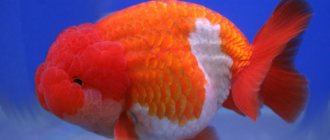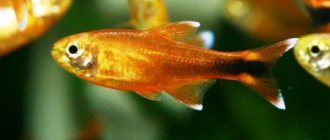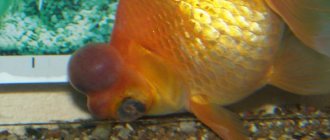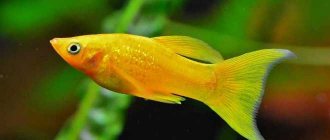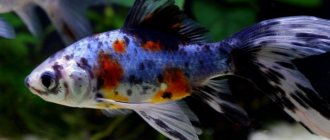Description of the fish
It is impossible to find such a fish in nature, since it was bred artificially in Japan. Ranchu's body shape is ovoid. The pelvic and pectoral fins are small - half the body height. The caudal fin is triangular in shape, formed by two fused caudal fins. The fish does not have a dorsal fin. In the tail part the spine is curved downwards.
Ranchu body color can be different, but the most popular are those with colored gills, eye circumference, lips and fins, head and a solid, most often white, body color.
Breeders managed to develop several breeds with slightly different shapes and colors. These are orange ranchu, calico, chocolate, metallic, black and their variations. In addition, when crossing lionhead and ranchu, a hybrid was obtained called lionhead ranchu. Adults grow up to 13 cm in length and live 10-15 years in good conditions.
Classification, appearance and appearance[edit]
Japanese, Thai, American and British ranchu breeders, as well as many prestigious goldfish breeding societies, adhere to two strict classifications of ranchu viewing, namely: ranchu
with
a top view and
selection criteria for
a side view
. [2] [5] [6] [7] [8] But Japanese aesthetic standards for ranches are more demanding. Ranchu is often compared to sumo wrestlers, as ranch is a round fish with an appendage, also known as a "bramble". [2] [5] However, traditional Japanese culture, aesthetics, and concepts view these attributes of both the ranchu wrestler and the sumo wrestler as an imposing and solid figure composed of massive circles and squares that are abstract representations of balance, proportion, dignity, graceful movement, and strength. [5]
Three ranches in a water bag at a retail store in Manchester, England.
Ranchu from above (TVR) [edit]
In ancient China, goldfish were kept in large vessels made of ceramic or porcelain; therefore people could only see the fish from above. For this reason, people have selected these goldfish, generation after generation, with the big belly, big wen, and dragon eye genes for top view purposes. Thus, top view ranchu is considered the best from an aesthetic point of view in Japan and China. The TVR should have a rectangular shape, a short tail and a large wen on the head. When swimming, their appearance is supposed to resemble a worm moving through the water, which gives the ranch its name (in Chinese, "ruan chong" means "egg-shaped worm"). [5] [2] [9]
Side view of Ranchu (SVR) [edit]
The back of the ranchu (when viewed from the side) has been compared to a traditional Japanese comb, which comes in two forms. First scallop
(
nagate
or long style) is long with rounded corners and looks like a koban coin.
While the second comb
(
marute
or round style) is shorter, round and similar to a round coin when viewed from the side, but still not as round as any modern round coins. Both comb shapes are acceptable in ranch shows and competitions. [5] [2] [9]
Selection and judging[edit]
Most goldfish shows and competitions judge the ranch in an aquarium, and the judges view the fish from the side and top, looking for behavior and whether the fish meets physical standards, movement, and movement. The attachment of the tail to the caudal peduncle is also carefully assessed. [2] Real Japanese ranchu is judged from above in shallow bowls rather than glass, although the overall shape of the ranchu is taken into account, the view from above is most important. Western goldfish societies still tend to use glass tanks for judging, but a number of societies based on Japanese methods are now operating and attempting to follow traditional ranchu breeding, keeping and judging methods. True Japanese ranchu enthusiasts store their ranch not in glass tanks, but in shallow ponds or vats.
Conditions of detention
They are kept only in spacious aquariums (one individual should have 50 liters of water). Water parameters should be as follows: temperature 18-25 degrees, hardness dH 8-25 degrees, acidity pH 6.0-8.0. Goldfish leave behind a lot of waste, so your aquarium must have good filtration. It is recommended to install an external filter. To saturate the water with oxygen you will need a compressor.
Once a week it is necessary to siphon the soil and change 25% of the water. Make sure that the readings of nitrogenous compounds (ammonia, nitrite, nitrate and phosphate) in the container do not increase. Excessive levels of these substances can lead to illness and death of pets. The concentration of nitrogenous compounds is monitored using drop tests sold in pet stores.
Choose any soil. There is no point in planting live plants in an aquarium, as they will be eaten. If you really want to decorate the container with greenery, purchase artificial plastic plants. You can also try tying Anubias to stones or snags or planting hard-leaved cryptocoryne in the ground, but it is not a fact that the ranch will not touch them.
Lionhead
What kind of fish is suitable for a mini aquarium?
What fish can be kept in mini aquariums? Pets with miniature body sizes should be placed in a small 10-20 liter tank. Fish 2-6 centimeters in length will tolerate this volume of water. But remember that even small fish want to swim in a spacious environment. They should not be kept in containers that will restrict movement. Territorial and aggressive fish should not be placed in mini aquariums. Which ones should not be placed in 10-liter aquariums? These are swordtails, medium-sized barbs, cichlids, gourami, and zebrafish. They have an active and energetic disposition and require more hiding space.
In an aquarium of 10-20 liters you can put small barbs, Gertrude pseudomugil, rice fish, cherry barbs, rasbor, erythrozonus, neons, Amanda tetra. You can also keep the following fish and shrimp there: otocinclus catfish, corydoras, amano shrimp, cherry shrimp, copper tetra. Representatives of the genus Poeciliaceae, viviparous fish, get along well in mini tanks.
You need to buy fish breeds with strong immunity, that is, not purebred fish, but hybrids. If you do not have the opportunity to buy a spacious “house” for your small pet, you need to buy a small aquarium with a capacity of 10 liters. The well-known Siamese cockerels are also often housed there. The cockerel can live alone and does not get along with its relatives; it is a fighting fish, after all.
What to feed the ranch
The diet of ranch, however, like other goldfish, should consist of 70% plant foods and 30% protein. You should not feed your fish bloodworms or worms, as this will cause problems with the gastrointestinal tract. Excellent food would be duckweed and specialized dry food for goldfish. Duckweed will have to be purchased or grown in a separate container on the window. Instead of duckweed, you can give your pets lettuce and spinach leaves.
Please note that goldfish are fed small meals 2-3 times a day. This is due to the peculiarities of digestion.
Chocolate
Feeding the golden barb
The fish is an omnivore. She can be given flakes specially made for tropical fish, and she will also happily eat live and frozen food. The most important thing is to add plant foods to the diet, otherwise the barb will begin to actively feed on the plants in the aquarium. They feed him two to three times a day; food should be eaten in about five minutes. Residues must be removed immediately to prevent the water in the aquarium from deteriorating.
Feeding any aquarium fish should be correct: balanced, varied. This fundamental rule is the key to the successful keeping of any fish, be it guppies or astronotuses. The article “How and how much to feed aquarium fish” talks about this in detail; it outlines the basic principles of the diet and feeding regime of the fish.
In this article, we note the most important thing - feeding fish should not be monotonous; the diet should include both dry food and live food. In addition, you need to take into account the gastronomic preferences of a particular fish and, depending on this, include in its diet food either with the highest protein content or, conversely, with plant ingredients.
Whatever your choice of food for aquarium fish, when purchasing, be sure to look at the expiration dates of the product, and do not buy food in bulk or in damaged packaging. Like any product, fish food deteriorates and if storage conditions are violated, pathogenic flora develops in it.
Breeding at home
Ranchu become sexually mature at the age of one year. In males, a rash appears on the gill wings, and in females, the abdomen becomes round and full. A few days before spawning, males are separated from females.
For spawning, an aquarium with a volume of 30-50 liters is used. A female and 1-2 males are planted in it. At the end of spawning, the parents are removed from the spawning tank. The aquarist monitors the eggs and removes the unfertilized ones. The fry will appear on the fifth day. They are fed dry food ground into dust.
Calico
Interesting things about Ranchu:
- In addition to the ranchu lionhead variety, the ranchu shubunkin and ranchu veiltail varieties were bred;
- Not all amateurs share the enthusiasm of Japanese breeders, and yet in the Land of the Rising Sun real clubs are being created whose task is to improve this species;
- The volume of the aquarium should be impressive - from 200 liters; rancha can also be kept in pools and ponds;
- The fry are painted black; they acquire their color only with age;
- The color of the ranch is different, the most valuable are those that have color spots scattered throughout the body or have colored gill wings and the area near the eyes.
(Visited 199 times, 1 visits today)
In aquarium and pond farming
The fish is suitable for keeping in a cold-water aquarium with plenty of space for free swimming. Beautiful in greenhouses. Due to the endurance of the breed, it can be kept in a decorative pond outside. Prefers a community of its own kind, bright light and plenty of free space. Effective filtration and regular water changes. When designing a reservoir, it is recommended to use loose fine-grained soil, stones, driftwood, live or plastic plants, including floating ones. When decorating, it is necessary to avoid the use of objects with sharp edges and edges, which could cause injury to the fish while swimming.
Links[edit]
- ^ a b c d Andrews, Dr. Chris. "The Interpet Guide to Fancy Goldfish", Interpet Publishing, 2002. - ISBN 1-902389-64-6
- ^ abcdefghij "GFSA - Ask the Judges", article on Lionchu by Larry Christensen, Peter Ponzio, Scott Taylor, Tony Reynolds and John Parker from the Goldfish Pages (Goldfish Society of America) website, date retrieved: May 27, 2007.
- Wolf, Hermann (1908). Breeds of goldfish and other aquarium fish, their care and reproduction: A guide to freshwater and saltwater aquariums, their fauna, flora and management. With 280 explanatory illustrations, printed with text. Innes and Sons. clause 11.
- "EGG" . Bristol Aquarium Society
. Bristol Aquarium Society. Retrieved October 13, 2018. - ^ abcdefghij Johnson, Dr. Eric L., DVM, and Richard E. Hess. "The Unusual Goldfish: A Complete Guide to Care and Collection", Weatherhill, Shambhala Publications, Inc., 2006. - ISBN 0-8348-0448-4
- "The Goldfish Connection - Goldfish Types: Ranchu, Retrieved May 22, 2007." . Archived from the original on 2007-04-16. Retrieved May 23, 2007.
- NEO Ranchu Classification and Standards, date retrieved: May 22, 2007, archived November 13, 2007, at the Wayback Machine
- Thai Ranchu Center Ranchu Standards and Classification, date restored, May 22, 2007, archived May 19, 2007, in the Wayback Machine
- ^ ab "What is Lionchu?" by Peter Ponzio, article from Goldfish Pages (American Goldfish Society), date retrieved: May 26, 2007.
| vte Breeds of goldfish | |
| |
Notes and footnotes
- N. F. Zolotnitsky, “Amateur Aquarium”
- "GFSA - Ask the Judges", an article about the Lionchu by Larry Christensen, Peter Ponzio, Scott Taylor, Tony Reynolds and John Parker, from the Goldfish Pages Website (Goldfish Society of America)
- [rafflesgold.com/ Virtual place for goldfish lovers] + (English)
- [www.youtube.com/watch?v=n69aypRQMSI Video: Lionhead Ranchu]
- [vermilliongoldfishclub.com/diary/mfgc2006/lionchu.html Exhibition winners of 2006 on the goldfish club website]
An excerpt characterizing the Lionhead Ranchu
At this time, the first blacksmith rose from the ground and, scratching the blood on his broken face, shouted in a crying voice: “Guard!” Killed!.. Killed a man! Brothers!.. - Oh, fathers, they killed him to death, they killed a man! - the woman squealed as she came out of the neighboring gate. A crowd of people gathered around the bloody blacksmith. “It’s not enough that you robbed people, took off their shirts,” said someone’s voice, turning to the kisser, “why did you kill a person?” Robber! The tall fellow, standing on the porch, looked with dull eyes first at the kisser, then at the blacksmiths, as if wondering who he should fight with now. - Murderer! – he suddenly shouted at the kisser. - Knit it, guys! - Why, I tied up one such and such! - the kisser shouted, waving off the people who attacked him, and, tearing off his hat, he threw it on the ground. As if this action had some mysteriously threatening significance, the factory workers who surrounded the kisser stopped in indecision. “Brother, I know the order very well.” I'll get to the private part. Do you think I won't make it? Nowadays no one is ordered to commit robbery! – the kisser shouted, raising his hat. - And let's go, look! And let's go... look! - the kisser and the tall fellow repeated one after another, and both moved forward along the street together. The bloody blacksmith walked next to them. Factory workers and strangers followed them, talking and shouting. At the corner of Maroseyka, opposite a large house with locked shutters, on which was a sign of a shoemaker, stood with sad faces about twenty shoemakers, thin, exhausted people in dressing gowns and tattered tunics. - He will treat the people properly! - said a thin craftsman with a scraggly beard and frowning eyebrows. - Well, he sucked our blood - and that’s it. He drove us, drove us - all week. And now he brought it to the last end, and left. Seeing the people and the bloody man, the worker who had been speaking fell silent, and all the shoemakers, with hasty curiosity, joined the moving crowd. -Where are the people going? - It is known where, he goes to the authorities. - Well, did our power really not take over? - And you thought how! Look what the people are saying. Questions and answers were heard. The kisser, taking advantage of the increase in the crowd, fell behind the people and returned to his tavern. The tall fellow, not noticing the disappearance of his enemy the kisser, waving his bare arm, did not stop talking, thereby drawing everyone’s attention to himself. The people mostly pressed on him, expecting from him to get a solution to all the questions that occupied them. - Show him order, show him the law, that’s what the authorities are in charge of! Is that what I say, Orthodox? - said the tall fellow, smiling slightly. – He thinks, and there are no authorities? Is it possible without bosses? Otherwise, you never know how to rob them. - What nonsense to say! - responded in the crowd. - Well, then they’ll abandon Moscow! They told you to laugh, but you believed it. You never know how many of our troops are coming. So they let him in! That's what the authorities do. “Listen to what the people are saying,” they said, pointing to the tall fellow. Near the wall of China City, another small group of people surrounded a man in a frieze overcoat holding a paper in his hands. - The decree, the decree is being read! The decree is being read! - was heard in the crowd, and people rushed to the reader. A man in a frieze overcoat was reading a poster dated August 31st. When the crowd surrounded him, he seemed embarrassed, but in response to the demand of the tall fellow who had pushed ahead of him, with a slight trembling in his voice, he began to read the poster from the beginning. “Tomorrow I’m going early to the Most Serene Prince,” he read (the brightening one! - the tall fellow solemnly repeated, smiling with his mouth and frowning his eyebrows), “to talk with him, act and help the troops exterminate the villains; We too will become the spirit of them...” the reader continued and stopped (“Saw?” the little one shouted victoriously. “He will untie you all the distance...”) ... - to eradicate and send these guests to hell; I’ll come back for lunch, and we’ll get down to business, we’ll do it, we’ll finish it, and we’ll get rid of the villains.” The last words were read by the reader in complete silence. The tall fellow sadly lowered his head. It was obvious that no one understood these last words. In particular, the words: “I will come tomorrow for lunch,” apparently even upset both the reader and the listeners. The understanding of the people was in a high mood, and this was too simple and unnecessary understandable; this was the very thing that each of them could say and that therefore a decree emanating from a higher power could not speak. Everyone stood in dejected silence. The tall fellow moved his lips and staggered.

